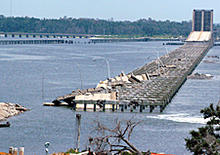Disaster Resilient Structures and Communities
(+$4 million)
Challenge

The past few years have reminded us that both natural hazards—including extreme winds, storm surge, wildland fires, earthquakes, and tsunamis—as well as terrorist actions, are a continuing and significant threat to U.S. communities.
The disaster resilience of our physical infrastructure and communities today is determined in large measure by the building codes standards and practices used when they were built. With few exceptions these legacy codes, standards, and practices—which have evolved over several decades—are oversimplified and inconsistent with current risk assessments. As construction and rebuilding costs continue to rise, there is increasing recognition of the need to move from response and recovery to proactively identifying and mitigating hazards that pose the greatest threats.
Proposed Program
Working in coordination with other agencies, NIST will develop:
- Standard methods to predict losses, evaluate disaster resilience, and estimate cost-to-benefit of risk management strategies at the community and regional scales as opposed to the individual building scale;
- Decision support tools to modernize codes, standards, and practices consistent with the risk;
- A validated "computational wind tunnel" for predicting extreme wind effects on structures; and
- Risk-based storm surge maps for the design of structures in coastal regions and an improved hurricane intensity classification scale.
Expected Impacts
A 2005 National Institute of Building Sciences study found that a dollar spent on hazard mitigation saves society an average of $4, with positive benefit-cost ratios for all hazard types studied. This initiative will improve community resiliency and protect property and lives through:
- Reduced risk from hurricanes and wind-storms, fires at the wildland-urban interface, and earthquakes;
- Science-based tools for more robust hazard mitigation assessments, better local and private resource allocation decisions, and guidance to communities for responding to large-scale, wildland-urban fires;
- Both short- and long-term improvement in seismic, wind, and fire provisions for model building codes; and
- Technical resources such as guidelines, manuals, and evaluation of mitigation technologies that enhance structural engineering practice.

